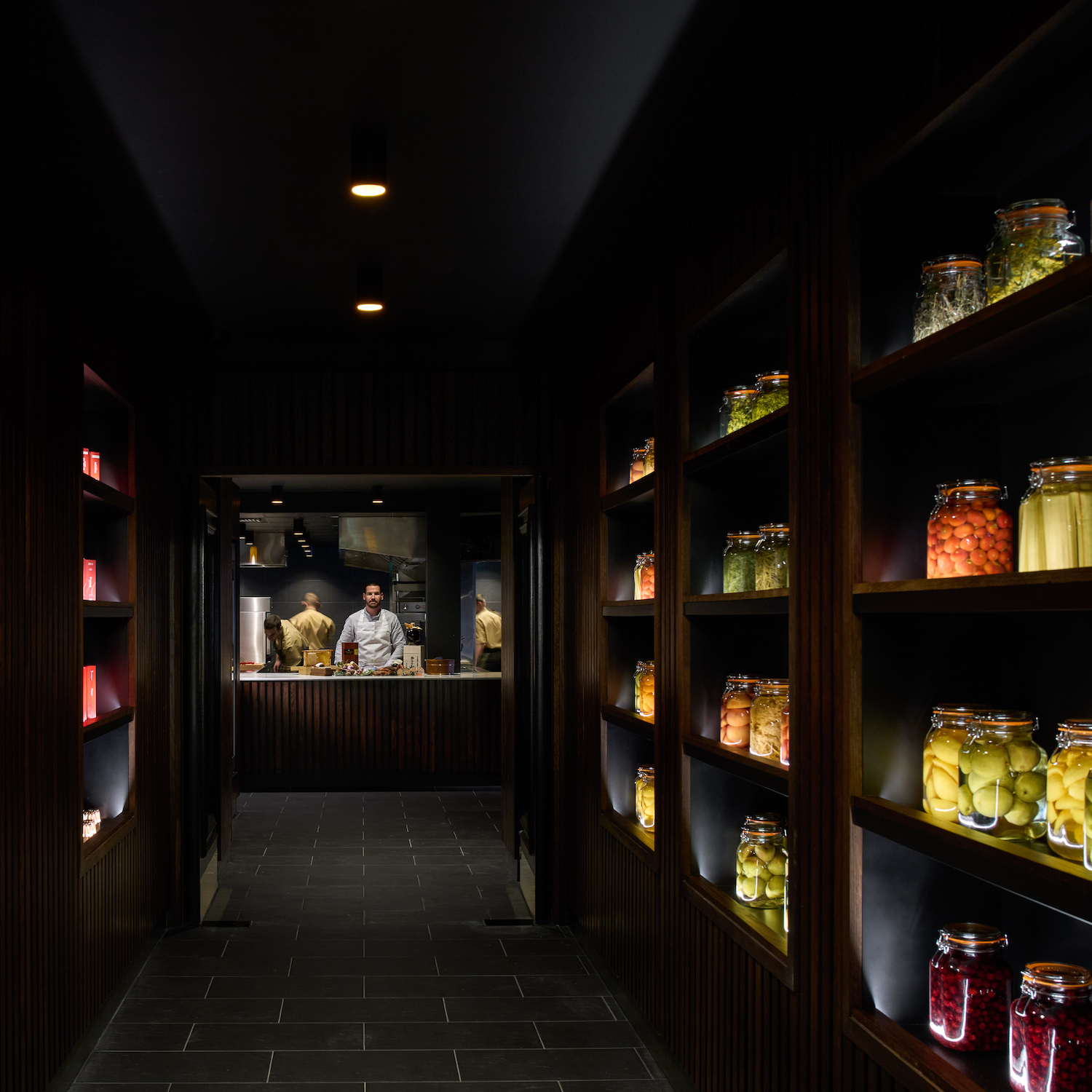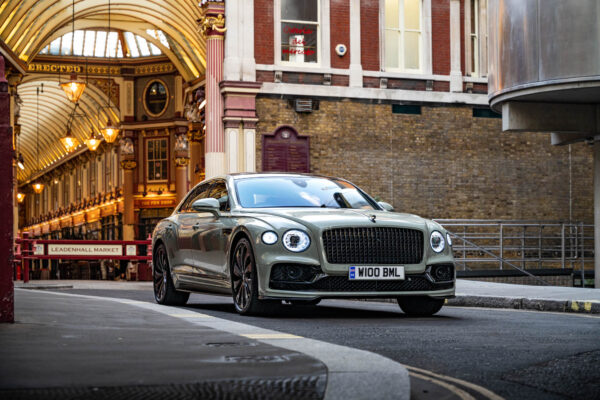The lighting is dramatically, moodily low. We’re guided through an opulent Georgian-inflected drawing room – all wing-backed chairs and warm mahogany – into a corridor stacked high on either side with an alchemist’s array of ferments, pickles and preserved treasures from both garden and seashore. We step onwards, into a sleek yet cosy dining room consisting of a mere three tables. A glimpse through the saloon doors beyond reveals a golden glow, a fiery flicker, the familiar metallic clang of a professional kitchen doing what it does best. Outside, the moon is rising over a spectral 12th century castle and manicured stately labyrinth.
Suddenly, the speaker system kicks into life, drowning out the click-clack of knives and sizzle of pans. Slash is loudly playing the iconic eight-note lick that kick-starts Guns ‘n’ Roses’ Sweet Child Of Mine.
Wait. What?
We can’t have been the first press group to crack into a broad smile at this bizarre juxtaposition. The slick and atmospheric backdrop of a spanking new restaurant surgically positioning itself for two Michelin star status (the inspectors were in a week prior to my visit, I’m informed) isn’t where you’d expect your first impressions to be formed by a soundtrack of 90’s grunge, 70’s psychedelic rock and live recordings of The Rolling Stones. However, Terre is so utterly an extension of chef patron Vincent Crepel’s idiosyncratic personality, it wasn’t long before the pieces of a gloriously impressive puzzle began slotting into place.
READ THE FEATURE IN THE ALICIA AGNESON EDITION HERE
Housed in the 18th century glamour of Castlemartyr Resort – a five-star country retreat nestled within 250 acres of pristine County Cork countryside – Terre embraces its eccentricities without ever once feeling restrained by the whims of gastronomic trends. A quick look at Crepel’s resume does a good job of explaining why; the French chef (quiffed, tattooed and somehow making it all look like the easiest job on the planet) worked his way up through Azark in San Sebastian, where he got a good look behind the velvet curtain to see the machinations that go into racking up those stars. A lengthy stint in Singapore’s finest eateries gave a further foundation of finesse and, seeking out a challenge, he decided to head to the Irish countryside and embed himself in a foodie scene that’s definitely beginning to turn heads. This is a chef that leads, accustomed to nothing less than pioneering the kitchens that make the rest of the world listen.
While there’s some justification for this move to the countryside (after all, Cork’s restaurant scene is definitely on the up and up), it’s still very much a gamble. Crepel’s response to this element of risk is clearly to go all in, showing a hand stuffed to the gills with aces. Championing an ingredients list with a set of food miles in the single figures, working in a globetrotting array of skills and techniques, and turning everything – and absolutely not just the music – right up to eleven, it’s no exaggeration to say that Terre exceeds even the loftiest of expectations.

Scene setting done, let’s turn to the dining experience itself. I’ll admit to being a little apprehensive when our maître d’ Fergus, a tall and besuited Irishman completely incapable of suppressing a knowing grin, told me we’re about to go on a ‘journey’. It’s a word trotted out more often than any food critic wishes, and usually means precisely nothing. However, Terre is literally laid out as a journey with five distinct stopping points. Each provides Crepel an opportunity to show – emphatically not tell, as the chef keeps talking to an understated minimum – his concepts, ambitions and reasoning for placing his newest venture on the edge of a small Irish village. What’s more, each destination genuinely adds to the experience, leaving myself and my fellow diners breathless with excitement.
First, Champagne – a fabulous vintage Blanc de Blancs – and a wander through the aforementioned rooms given their unique ambience by Axl Rose wailing his overblown-yet-nostalgia-inducing nonsense. We’re led to the ferments room, with jars of samphire, rosehip, rhubarb, sea purslane and fennel flowers backlit in ways both reminiscent of a Turner Prize-winning assemblage and a scene from a horror movie. The opposite wall holds an exhibition of Michelin Guides dating back to 1984: the chef’s personal collection, and a hell of a hint to the inspectors.
We’re gestured into the open kitchen. Vincent shouts a brisk ‘Welcome!’ and seven other chefs echo his salutation in unison with military precision. So far, so theatrical, and only mildly terrifying. We take our places at the vast chef’s table, and the first course is underway. One by one, members of the kitchen team step up to proudly present their creations: a trio of one-bite delights housed in pastry cups of near-impossible thinness and crispness. The first: smoked veal, anchovy, sea purslane. The second: stone crab, finger lime and maple syrup (I catch my dining partner’s eye and we both proclaim with no small delight that it’s a key lime pie, albeit whacked with a massive dollop of the sweetest and juiciest of shredded crustacean), and the third boasts Ballycotton blue lobster and an array of botanicals. All three are distinct, delicious, and demonstrate that there’s no gentle easing into the tasting menu we’ve embarked upon. It’s quite the opening act, and one that sends a resounding message: there’ll be no delicate flavours or ephemeral and diaphanous sensory subtleties tonight, boys.

We’re off again. This time, we’re brought to an ice box situated almost uncomfortably close to where Vincent is working wonders with a blade and a bivalve, and where a local chap on the team takes us through some of the key ingredients and concepts of the tasting menu. We’re told about some of the rare and unusual caviars that play a key role, shown the particular type of quail we’ll be eating, and cordially introduced to the live cousins of the crabs and lobsters we’ve just eaten. We’re shown a limited release whiskey that was distilled just down the road in Midletown, and informed by our guide it’s nothing short of a crime to cook with it. Clearly what Vincent wants, Vincent gets. We’re not complaining.
This clash of blasphemy and gastronomy is interrupted by a flash of the divine. Yet another member of the kitchen team reaches over to present us with a small cylinder of raw A5 Wagyu from the Miyazaki Prefecture, held in a leaf of dried nori with some truffle and hazelnut. It melts in the mouth like no piece of beef I’ve ever had before, leaving behind a deeply savoury satisfaction that lingers, and lingers, and lingers. Wow.

Fergus is back, and briskly walks us to the main dining room. Filip, the restaurant’s sommelier, begins the wine flight in earnest (which brought bottle after bottle of low-yield, small production wines which – gasp – occasionally strayed beyond the borders of France and into Spain and Italy) along with the first salvo of the fish courses. It’s yet another exercise in meticulously-crafted sensory bombast; coils of pickled radish are stuffed with vivid orange trout roe. A fat, unctuous scallop is draped with silky lardo and slivers of lobster.
Because this is 2022, there’s a chawanmushi. However, because this is Terre, it’s heightened with eel and cured wagyu, and given fathoms of heft with foie gras and a 46-month aged parmesan. Best of all, a wedge of opalescent turbot, cooked to absolute perfection, comes topped with an extremely generous quenelle of what has to be – and I don’t say this lightly – the best caviar I’ve ever tasted. Jasmine-hued, impossibly creamy and nutty, low in salinity, it’s a genuine high point in a tasting menu with more peaks than the Alpine regions half our wine list hails from. The mains are rounded off with the quail from the kitchen encounter an hour earlier, sitting upon a sauce of smoked porcini and pied de mouton. Unsurprisingly, it’s spectacular.

Vincent himself comes to the tableside to serve the dessert – a matured Mauritian pineapple, with grated Buddha’s Hand citrus, both of which are about as unseasonal and unregional as a sweet course can be, and unapologetically so. However, the bowl features cured rhubarb root from the garden outside the restaurant window, and all is forgiven with a flambé of 23-year old Zacapa rum. In a fascinating left turn from a wine flight typified by deeply perfumed bottles, it’s served with a Normandy pear cider. Deliciously lending a crispness and briskness, the choice of drink brings out a reflection of the tart acidity that rang through the very first courses.
We end our journey in the Georgian drawing room, snuggled up against a roaring fire with petits fours and a drinks trolley – who doesn’t love a drinks trolley? – featuring Armagnac, Sherry and a range of rare digestifs. It veers dangerously close to overkill. Despite this, it would be almost criminal to serve anything but this final flourish of enveloping flavours in a room this cosy, this opulent, and this much of a contrast to the bracing contemporary nature of the previous stops on our evening’s voyage. On the stereo, Roger Daltry is belting out The Who’s opus, Baba O’Riley. “Out here in the fields, I fight for my meals…” The irony is not lost.
Terre is unabashedly the vision of a singularly remarkable talent, continuing his journey into gastronomic superstardom. There’s clearly some nerves surrounding whether or not it can draw in adequate foodie crowds, due to its rural location across the Celtic Sea. However, with multiple 1-hour flights from London each day and only a short hop from Cork airport, a very comfortable array of quintessentially 5-star rooms and suites to stay in on-site and food this thrilling, there’s no doubt it’s unquestionably worth the effort.


